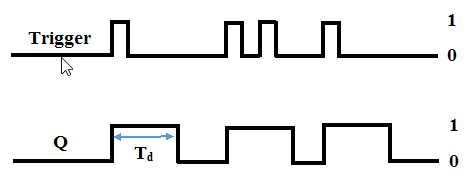Monostable Flip-Flop
Raising edge, falling edge, either edge monostable flip-flop
Libraries:
Simscape /
Electrical /
Control /
General Control
Description
The Monostable Flip-Flop (or monostable multivibrator) block generates a single output pulse of a specified duration when it is triggered externally. The external trigger is a Boolean signal. Pulse generation is triggered when a change is detected in the external trigger signal. The change detection can be:
Rising edge
Falling edge
Either edge
When the output is true, a change in the external trigger signal has no effect.
The operation of a monostable flip-flop is represented in the following figure:

Ports
Input
Output
Parameters
Extended Capabilities
Version History
Introduced in R2018b
